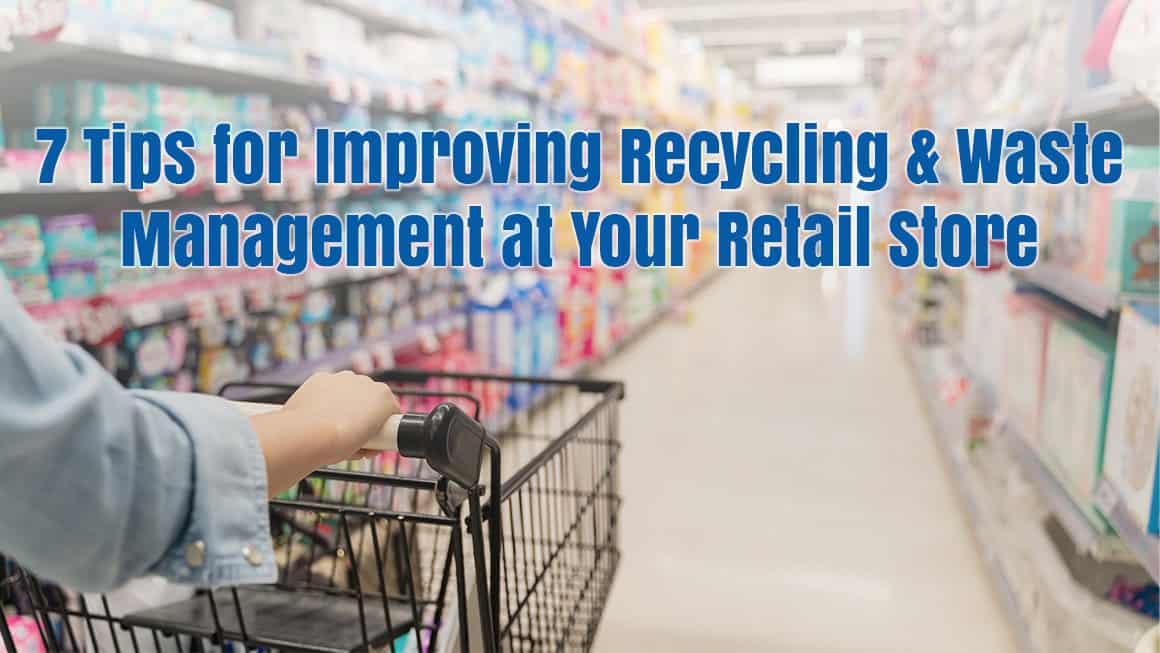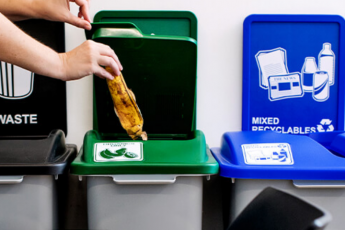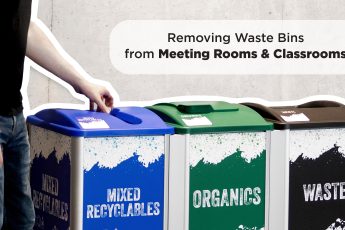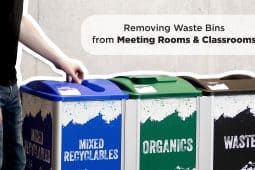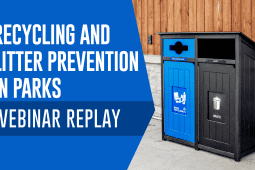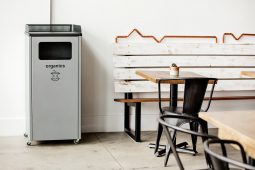Having an effective recycling and waste management program at your retail store will not only reduce your store’s environmental footprint, but also help you cut costs, improve your brand image, and align with customer values. Here are 7 key tips we’ve gathered that will help you build the retail recycling and waste program you’ve always wanted and save you money in the process.
Let’s start with the facts.
There are many different factors that can impact the performance of the recycling and waste program at your retail store. For retailers, the store should be a representation of the company’s values and best qualities, including a strong product assortment and a commitment to more sustainable operations. By running a retail recycling program, you can help ensure that the amount of waste that ends up in landfills is reduced, and that recyclable items are turned into new products.
- In a National Solid Waste Benchmarking Study conducted in 2014, 1,012 retail stores, offices and retail centers across Canada produced an average diversion rate of 54.75%.
- In the same study, Retail Stores were found to have an average diversion rate of 66.71%, while Retail Centers averaged 42.33%.
- The largest composition of divertible materials recovered at retail stores, offices and retail centers are as follows: 64.8% Cardboard, 14.14% Organics, 8.12% Paper, 4.62% Mixed Plastics, Glass & Metal.
- Shoppers worldwide are estimated to be using upwards of 1 trillion single-use plastic bags per year.
- Recent studies estimate there are over 170 trillion pieces of plastic floating in the world’s oceans
At a time when consumers are highly motivated to associate with companies that are committed to sustainability, it’s essential for every retail store to have an effective recycling program in place. An effective program focuses on reducing waste, reusing useful materials and recycling them. Ineffective retail collection programs often result in significant amounts of waste being sent to landfills, leading to high disposal costs. Let’s look at 7 ways you can enhance the effectiveness of your in-store waste management program:
-
Always begin with a preliminary waste audit to categorize and quantify your waste
Step one of building a successful waste management program for any industry begins with identifying and categorizing the types and quantity of waste produced by every department of your organization. Use a map of your retail space and surrounding grounds to identify key areas (i.e. entrances, bathrooms, checkouts, private offices, warehouse, etc.) and begin to identify what types of waste is being generated in each area.
Performing a preliminary waste audit will give you a better understanding of the current state of waste in your store so that you can pinpoint specific areas for improvement to optimize your waste management program.
Learn how to perform a waste audit here.
-
Build a Green Team
How much time do your employees have to spare for sustainability initiatives?
If the answer is less than you would like, a green team can be the most valuable ally in your quest for building an effective recycling program.
A Green Team can be a small group of employees whose combined goal is to educate, empower and inspire fellow staff and customers to establish and promote sustainable practices within your organization. Every new initiative needs a full launch campaign and a group of influencers that will help build the momentum of your program.
To set up your green champions for long term success, make sure this group has formal oversight, tools for measurement and verification, and a clear mission.
-
Understand your landlord and partner-up with store managers & facility management staff
You yourself as a tenant may not always have direct control of certain features. Furthermore, you may not have financial incentives for sustainability investments — individual stores in certain properties may not be submetered, meaning that you cannot track energy savings. In those cases, the utilities are billed on a per-square-footage basis rather than on actual consumption, so if one store decreases its utility use, the savings are shared across all the tenants–generally called the “split incentive” issue.
To overcome this, progressive retailers are beginning to open the sustainability dialogue with their landlords. Find your corporate counterpart with your key landlords to discuss the possibilities. Identify opportunities for property-wide initiatives and solicit buy-in from other tenants. Try to kick off recycling pilot projects and develop case studies to share with other properties. And to overcome the “split incentive” issue, consider new shared cost financing mechanisms or rewards for projects that save costs.
-
Modify your operational habits
The daily operations of your retail store present the opportunity to test various waste management techniques.
Reducing the amount of waste in your store can begin with small changes. Here are some creative examples to inspire you:
- Cut down on eCommerce packaging: Nearly every retail operation has an online component of some sort, which means shipping materials are included in their waste footprint. According to Capital One, an estimated 356 billion packages were shipped worldwide in 2023. It’s not always possible, depending on your product, but always be cognizant of how you can reduce the amount of packaging your products use. Here’s a list of some great sustainable packaging options.
- Institute a take-back program! A take-back program involves a retailer taking back their products from the consumer. Customers are usually quite happy to find someone willing to take their used products, so much so that finding somewhere to legally return it serves as its own reward. Best Buy has implemented a program where customers can trade-in a working device and receive an in-store gift card, as well as offering in-store recycling for batteries and other electronic devices!
- Other entrepreneurs are opening outlets boasting zero waste. Lauren Singer, author of the blog “Trash is for Tossers” has set up Package Free Shop, which ships using packaging that is 100% recyclable and 100% compostable.
- Ex-Amazon employee Tamara Limis establishing The Wally Shop, with fresh food items to be delivered in reusable containers.
- Avoid over-production of marketing and publicity material by reviewing distribution lists and regularly updating databases.
- Do you offer in-store coffee? Avoid purchasing disposable catering products such as milk cartons, sugar packets and paper plates.
- Place recycling bins inside your store, in the break room, or outside near the entrance to give customers and employees the opportunity to divert recyclable items.
- Try to minimize excessive packaging when your customers make a purchase. This can be as simple as asking if your customer wants a bag instead of assuming that they do.
- Work with staff and vendors to keep disposable packages and other potential waste materials out of your venue. You can begin by substituting reusables for disposables, at concessions or behind the scenes; encourage refilling of water bottles; switch to reusable transport packaging, and so on.
-
Re-evaluate Disposal Habits with your Hauler
Not long ago, waste removal was mostly built around collecting co-mingled materials and sending the waste to landfills, where it was incinerated or compacted by waste disposal companies. These days, however, your green team, facility management/custodial staff and your landlord can take an active role in managing part of the process.
Before you can begin a recycling program, you’ll need to find a hauler. Larger retail locations that produce more waste may need to find a hauler to come in and pick up their recycling. In many cases, your waste hauler may also offer recycling services, so reach out to them first. If your property management company is the one that manages your waste, you may need to talk with your property manager to see if they already have agreements in place with a hauler to do recycling.
And definitely be aware of pickup locations.
Tenant participation is largely driven by ease of implementation rather than the retailers’ corporate objectives in the majority of scenarios. At the end of a long workday, your average store employee is unlikely to walk across the property to drop off recycling if the trash is easier to access, regardless of any corporate goals they’ve read in their onboarding booklet. Not surprisingly, the highest recycling participation is from tenants closest to the collection areas. Be sure to have these discussions with your hauler to improve the likelihood of proper disposal of your divertible materials.
-
Choose the right recycling stations and place them appropriately
There’s a variety of factors you need to consider when purchasing containers to suit each space around your retail store —too many to cover in this blog! However, as a start, if you want the recycling and waste management at your retail store to be successful, it’s imperative that you choose containers that keep all the collection streams together, regardless of their location across your business’ grounds.
For example, if there isn’t a recycling or organics stream directly next to the trash stream, customers just end up tossing all their waste in the most convenient bin—the closest one. This leads to enormous amounts of contamination, which can derail your sustainability goals due to your recycling and organics ending up in the landfill rather than being properly sorted at your community’s Material Recovery Facilities (MRF).
Quickly, some other things to consider when choose the right recycling & waste station are:
- Placement
- Capacity
- Restrictive Openings
- Signage & Label Customization Capabilities
Make sure you’ve located well-marked, easy to use recycling containers throughout your retail space – and make sure every time there’s a trash bin, there’s a recycling bin next to it, including at each employee’s desk. Some modern retail stores have taken this strategy even farther by creating zero waste stations with fewer waste receptacles, instead offering more containers for recycling (and organics) collection. Inconvenient recycling containers can deter people from recycling, but if there’s a bin everywhere a customer or employee is likely to discard their waste, it’s hard for them to find an excuse not to recycle.
-
Communication is key!
Make sure employees and customers know about your new or existing recycling initiatives. Incorporate recycling program education into your employee onboarding. Create easy-to-understand signs for your recycling & waste stations. Including pictures on signs of common in-store materials is a great way to clarify which stream each item belongs in. PSAs or other in-store announcements about recycling, posters, contests, and blurbs in programs can all help involve customers and make sure they’re disposing of materials correctly. In a recent study, shelf strips with in-store recycling information improved customer awareness and education of retail recycling programs.
Consider including customer education about your initiative on your website and on social media. It’s also essential to communicate with custodial/janitorial/property management team and involve them in the process from the beginning. If your janitorial staff doesn’t understand the value of your program, or the new process, they can unintentionally derail your program in a number of different ways. Involving your custodial staff at the beginning of the design stage can also help you implement a more effective program as they have insight into user behavior that you might not be aware of. You also want to make sure you’re not creating additional work for your staff that will drive up operational costs.
-
Bonus Tip! Track performance with data.
A successful retail waste diversion program includes participation from employees, occupants, shoppers, and/or visitors, depending on the type of business. While the lack of conclusive causation continues to be a challenge, the continuation of communication between retailers is getting us closer to building a successful blueprint for recycling program implementation across the many different types of retail spaces.
Solid waste diversion is a key environmental and operational performance indicator tracked by a growing number of real estate management companies at both corporate and property levels. The amount of waste generated, recycled, and disposed of has implications to operational costs, and is a tangible indicator of stakeholder engagement. This is a fantastic metric to start with as it’s relatively simple to track. From there, you can start to add more granular metrics, such as contamination rate, participation rate, weight collected per day, etc. All of which will get you closer to your zero waste goals.
Start your retail recycling program off on the right foot by taking advantage of these 7 industry secrets to improving recycling and waste management in your retail store! Once you’ve launched your in-store recycling program, you’ll start to see many more areas for improvement. These minor or major improvements will continue to increase your diversion rate and positive impact on the environment, reduce your costs and ultimately enhance brand loyalty with your staff and your customers.
Need help getting started? These tips are a great start for improving the recycling and waste management at your retail store, but our team can help you implement these suggestions. Contact us to chat with our Retail Recycling Program Specialists for more direction on where to begin your journey to waste management greatness.
